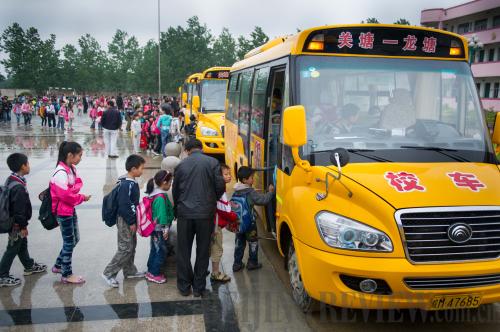|
 |
|
SAFE JOURNEY: Children board school buses at Guantang Primary School in Tianchang, east China's Anhui Province, on May 16, 2012 (DU YU) |
However, Tu Yanguo, Director of the College of Education of Central China Normal University, expressed his concerns for the future of China's rural education. "Although the MOE has halted the mergers, their effects are still creating problems for local education authorities and schools," Tu said. He said that excessive mergers have had a negative effect on teaching quality, school safety and accommodations for students.
The removal of village primary schools has led to overcrowding. In Butuo County's Ethnic Primary School, the admissions quota is set at less than 1,200, yet their current student body numbers 1,800.Meanwhile, a survey conducted in 2008 by the education authorities of Shaoyang County in central China's Hunan Province showed that the average number of students per class in local primary, middle and high schools was 63, which was above the provincial standard. Four classes in Shaoyang No.1 Middle School even exceeded 100 students.
Even if township schools are large enough, most of them are located far away from villages and very few offer bus services. According to the NAO, over 1,700 schools offered bus services, only 6.77 percent of those surveyed. More than 412,000 students are forced to hire rides independently without proper oversight, the NAO report showed.
Concerned about safety, more and more parents prefer their offspring attend boarding school or move closer to towns. But boarding school dorms can only meet 84 percent of demand for 5.54 million students who apply for such accommodation, the NAO report says.
"It's a good thing to gather rural students together to attend middle school in townships, for better education," said Han with the Chinese Education Society. "But for young children, this is not such a good idea since they need to be taken care of.
"In addition, the expenses of rent and transportation will be a large burden for most rural families," he added.
Under such pressure, many rural children have chosen to abandon their rights to education and just drop out, Han said, adding that the trend will further worsen the rising disparity in rural and urban education.
Addressing inequality
For a long time, the rural-urban education gap has been a headache for China. The government has done a great deal to close the gap, from providing nine years of free education for all rural students starting from 2006, to the annual input of 16 billion yuan ($2.57 billion) in a 2011 program to provide 26 million rural students with free lunches.
China currently exempts students in both urban and rural areas from school fees during the compulsory education period, provides free textbooks for students from needy families and offers living allowances to underprivileged students from rural areas. China's nine-year compulsory education program typically consists of six years of primary school and three years of middle school.
Meanwhile, according to a statement released by the Ministry of Finance (MOF) on May 8, public expenditure on education in China reached 2.2 trillion yuan ($353 billion) in 2012, accounting for 4 percent of the national GDP.
China is shifting its growth pattern by enhancing education, with more resources allocated to rural, remote and poor schools last year, the MOF said. In 2012, the country earmarked 86.5 billion yuan ($13.9 billion) from its central budget to support rural compulsory education. The government has also provided allowances for more than 13 million students who came from poor families and attended boarding schools in central and western regions.
Despite the encouraging achievements, some areas leave much to be desired, such as in bridging the gap between the quality of education in urban and rural areas, and between key schools and ordinary schools, said Minister of Education Yuan Guiren.
"The free nine-year compulsory education only ensures that every child can receive an education. We see some people paying extra fees for their children to be admitted to key schools, which results from the disparity of educational quality in different areas," Yuan said.
| 